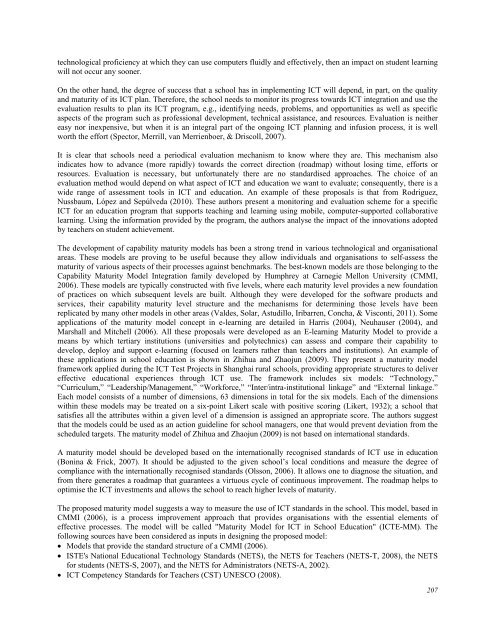A Maturity Model for Assessing the Use of ICT in School Education
A Maturity Model for Assessing the Use of ICT in School Education
A Maturity Model for Assessing the Use of ICT in School Education
Create successful ePaper yourself
Turn your PDF publications into a flip-book with our unique Google optimized e-Paper software.
technological pr<strong>of</strong>iciency at which <strong>the</strong>y can use computers fluidly and effectively, <strong>the</strong>n an impact on student learn<strong>in</strong>g<br />
will not occur any sooner.<br />
On <strong>the</strong> o<strong>the</strong>r hand, <strong>the</strong> degree <strong>of</strong> success that a school has <strong>in</strong> implement<strong>in</strong>g <strong>ICT</strong> will depend, <strong>in</strong> part, on <strong>the</strong> quality<br />
and maturity <strong>of</strong> its <strong>ICT</strong> plan. There<strong>for</strong>e, <strong>the</strong> school needs to monitor its progress towards <strong>ICT</strong> <strong>in</strong>tegration and use <strong>the</strong><br />
evaluation results to plan its <strong>ICT</strong> program, e.g., identify<strong>in</strong>g needs, problems, and opportunities as well as specific<br />
aspects <strong>of</strong> <strong>the</strong> program such as pr<strong>of</strong>essional development, technical assistance, and resources. Evaluation is nei<strong>the</strong>r<br />
easy nor <strong>in</strong>expensive, but when it is an <strong>in</strong>tegral part <strong>of</strong> <strong>the</strong> ongo<strong>in</strong>g <strong>ICT</strong> plann<strong>in</strong>g and <strong>in</strong>fusion process, it is well<br />
worth <strong>the</strong> ef<strong>for</strong>t (Spector, Merrill, van Merrienboer, & Driscoll, 2007).<br />
It is clear that schools need a periodical evaluation mechanism to know where <strong>the</strong>y are. This mechanism also<br />
<strong>in</strong>dicates how to advance (more rapidly) towards <strong>the</strong> correct direction (roadmap) without los<strong>in</strong>g time, ef<strong>for</strong>ts or<br />
resources. Evaluation is necessary, but un<strong>for</strong>tunately <strong>the</strong>re are no standardised approaches. The choice <strong>of</strong> an<br />
evaluation method would depend on what aspect <strong>of</strong> <strong>ICT</strong> and education we want to evaluate; consequently, <strong>the</strong>re is a<br />
wide range <strong>of</strong> assessment tools <strong>in</strong> <strong>ICT</strong> and education. An example <strong>of</strong> <strong>the</strong>se proposals is that from Rodriguez,<br />
Nussbaum, López and Sepúlveda (2010). These authors present a monitor<strong>in</strong>g and evaluation scheme <strong>for</strong> a specific<br />
<strong>ICT</strong> <strong>for</strong> an education program that supports teach<strong>in</strong>g and learn<strong>in</strong>g us<strong>in</strong>g mobile, computer-supported collaborative<br />
learn<strong>in</strong>g. Us<strong>in</strong>g <strong>the</strong> <strong>in</strong><strong>for</strong>mation provided by <strong>the</strong> program, <strong>the</strong> authors analyse <strong>the</strong> impact <strong>of</strong> <strong>the</strong> <strong>in</strong>novations adopted<br />
by teachers on student achievement.<br />
The development <strong>of</strong> capability maturity models has been a strong trend <strong>in</strong> various technological and organisational<br />
areas. These models are prov<strong>in</strong>g to be useful because <strong>the</strong>y allow <strong>in</strong>dividuals and organisations to self-assess <strong>the</strong><br />
maturity <strong>of</strong> various aspects <strong>of</strong> <strong>the</strong>ir processes aga<strong>in</strong>st benchmarks. The best-known models are those belong<strong>in</strong>g to <strong>the</strong><br />
Capability <strong>Maturity</strong> <strong>Model</strong> Integration family developed by Humphrey at Carnegie Mellon University (CMMI,<br />
2006). These models are typically constructed with five levels, where each maturity level provides a new foundation<br />
<strong>of</strong> practices on which subsequent levels are built. Although <strong>the</strong>y were developed <strong>for</strong> <strong>the</strong> s<strong>of</strong>tware products and<br />
services, <strong>the</strong>ir capability maturity level structure and <strong>the</strong> mechanisms <strong>for</strong> determ<strong>in</strong><strong>in</strong>g those levels have been<br />
replicated by many o<strong>the</strong>r models <strong>in</strong> o<strong>the</strong>r areas (Valdes, Solar, Astudillo, Iribarren, Concha, & Visconti, 2011). Some<br />
applications <strong>of</strong> <strong>the</strong> maturity model concept <strong>in</strong> e-learn<strong>in</strong>g are detailed <strong>in</strong> Harris (2004), Neuhauser (2004), and<br />
Marshall and Mitchell (2006). All <strong>the</strong>se proposals were developed as an E-learn<strong>in</strong>g <strong>Maturity</strong> <strong>Model</strong> to provide a<br />
means by which tertiary <strong>in</strong>stitutions (universities and polytechnics) can assess and compare <strong>the</strong>ir capability to<br />
develop, deploy and support e-learn<strong>in</strong>g (focused on learners ra<strong>the</strong>r than teachers and <strong>in</strong>stitutions). An example <strong>of</strong><br />
<strong>the</strong>se applications <strong>in</strong> school education is shown <strong>in</strong> Zhihua and Zhaojun (2009). They present a maturity model<br />
framework applied dur<strong>in</strong>g <strong>the</strong> <strong>ICT</strong> Test Projects <strong>in</strong> Shanghai rural schools, provid<strong>in</strong>g appropriate structures to deliver<br />
effective educational experiences through <strong>ICT</strong> use. The framework <strong>in</strong>cludes six models: “Technology,”<br />
“Curriculum,” “Leadership/Management,” “Work<strong>for</strong>ce,” “Inter/<strong>in</strong>tra-<strong>in</strong>stitutional l<strong>in</strong>kage” and “External l<strong>in</strong>kage.”<br />
Each model consists <strong>of</strong> a number <strong>of</strong> dimensions, 63 dimensions <strong>in</strong> total <strong>for</strong> <strong>the</strong> six models. Each <strong>of</strong> <strong>the</strong> dimensions<br />
with<strong>in</strong> <strong>the</strong>se models may be treated on a six-po<strong>in</strong>t Likert scale with positive scor<strong>in</strong>g (Likert, 1932); a school that<br />
satisfies all <strong>the</strong> attributes with<strong>in</strong> a given level <strong>of</strong> a dimension is assigned an appropriate score. The authors suggest<br />
that <strong>the</strong> models could be used as an action guidel<strong>in</strong>e <strong>for</strong> school managers, one that would prevent deviation from <strong>the</strong><br />
scheduled targets. The maturity model <strong>of</strong> Zhihua and Zhaojun (2009) is not based on <strong>in</strong>ternational standards.<br />
A maturity model should be developed based on <strong>the</strong> <strong>in</strong>ternationally recognised standards <strong>of</strong> <strong>ICT</strong> use <strong>in</strong> education<br />
(Bon<strong>in</strong>a & Frick, 2007). It should be adjusted to <strong>the</strong> given school’s local conditions and measure <strong>the</strong> degree <strong>of</strong><br />
compliance with <strong>the</strong> <strong>in</strong>ternationally recognised standards (Olsson, 2006). It allows one to diagnose <strong>the</strong> situation, and<br />
from <strong>the</strong>re generates a roadmap that guarantees a virtuous cycle <strong>of</strong> cont<strong>in</strong>uous improvement. The roadmap helps to<br />
optimise <strong>the</strong> <strong>ICT</strong> <strong>in</strong>vestments and allows <strong>the</strong> school to reach higher levels <strong>of</strong> maturity.<br />
The proposed maturity model suggests a way to measure <strong>the</strong> use <strong>of</strong> <strong>ICT</strong> standards <strong>in</strong> <strong>the</strong> school. This model, based <strong>in</strong><br />
CMMI (2006), is a process improvement approach that provides organisations with <strong>the</strong> essential elements <strong>of</strong><br />
effective processes. The model will be called "<strong>Maturity</strong> <strong>Model</strong> <strong>for</strong> <strong>ICT</strong> <strong>in</strong> <strong>School</strong> <strong>Education</strong>" (<strong>ICT</strong>E-MM). The<br />
follow<strong>in</strong>g sources have been considered as <strong>in</strong>puts <strong>in</strong> design<strong>in</strong>g <strong>the</strong> proposed model:<br />
<strong>Model</strong>s that provide <strong>the</strong> standard structure <strong>of</strong> a CMMI (2006).<br />
ISTE's National <strong>Education</strong>al Technology Standards (NETS), <strong>the</strong> NETS <strong>for</strong> Teachers (NETS-T, 2008), <strong>the</strong> NETS<br />
<strong>for</strong> students (NETS-S, 2007), and <strong>the</strong> NETS <strong>for</strong> Adm<strong>in</strong>istrators (NETS-A, 2002).<br />
<strong>ICT</strong> Competency Standards <strong>for</strong> Teachers (CST) UNESCO (2008).<br />
207
















